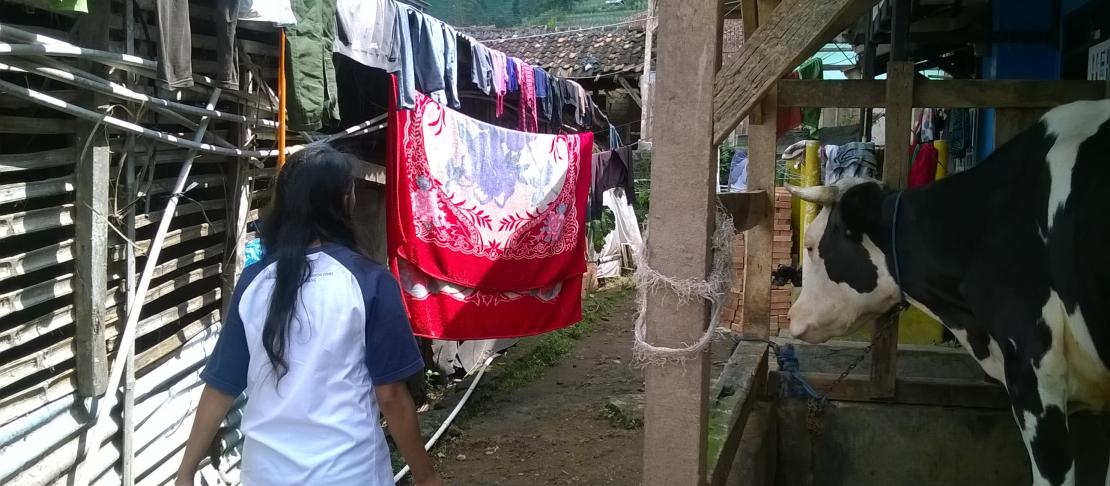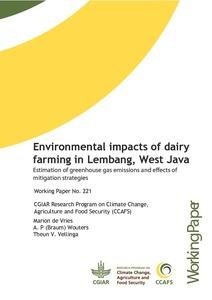Opportunities for reducing greenhouse gas emissions in small peri-urban dairy farms in Java, Indonesia

Improved feeding and manure management practices benefit farmers and reduce greenhouse gas emissions.
The demand for milk and dairy products is growing in Indonesia, but land resources are scarce and often fragmented. This has led to land for feed production for dairy cattle being disconnected from the location where milk and manure are produced. As a consequence, the dairy sector is experiencing problems obtaining sufficient and good quality roughage and recycling manure as a fertilizer. In a recent study, we found that current feeding and manure management practices are also contributing to increased greenhouse gas emissions from Indonesian dairy farms.
Dairy production is growing in Indonesia due to both rising consumer demand and the government’s goal to expand domestic milk production to increase the country’s self-sufficiency and reduce dependency on imports. The vast increase in demand is an opportunity for Indonesian dairy farmers to increase milk production and income, and thus improve their livelihoods.
But, at the same time, Indonesia has committed to reducing national greenhouse gas emissions by 29-41%, as compared to the business-as-usual scenario by 2030. Since dairy farming is a significant contributor to global warming via emissions of methane, nitrous oxide and carbon dioxide, how will Indonesian dairy farms be able to increase milk production and reduce greenhouse gas emissions at the same time?
Carbon footprint of typical dairy farms in Java, Indonesia
The Indonesian dairy sector is characterized by small-scale, zero-grazing dairy farms with four to five dairy cows and below-potential productivity. Nearly all dairy farms in Indonesia are located on Java, one of the most densely populated islands on Earth. As a consequence, most farmers own or rent a small area of land for fodder production, and that land is often located far away from the cow barn. Manure is often discharged as-is from the barn, causing nuisance for nearby residents and public health risks.
A team of researchers from Wageningen Livestock Research, including me, investigated the global warming potential of current farming practices of dairy farms in Lembang district, West-Java. We found that an average dairy farm in Lembang emits 33 ton CO2e per year, which is equal to 1.9 kg CO2e per kg fat and protein corrected milk (FPCM), a unit of measurement that allows comparison of the carbon footprint of dairy products.
We found that manure management contributed almost a third of the emissions from dairy production chains; and most manure management emissions were caused by the discharging of manure. A survey of 300 dairy farmers in Lembang district showed that more than 80% of farmers are discharging at least part of the cattle manure to the environment.
At the same time, farmers use synthetic fertilizer on part of the land for fodder production instead of cattle manure. Production and application of synthetic fertilizer contributes to additional emissions.
The survey also showed the feed ration of dairy cattle in Lembang district consists mainly of grass, rice straw, tofu waste, cassava waste, and compound feed. Farmers have problems accessing sufficient green fodder during the dry season so they replace part of the green fodder with rice straw and additional compound feed to avoid a decrease in milk production. We found that both rice straw and compound feed increase the carbon footprint of dairy due to relatively high emissions from the production and processing of these feed ingredients, and the low nutritional quality of rice straw.
Our research identifies several other feeding practices that caused below-potential productivity; these practices include insufficient roughage in the diet, not feeding cows according to their individual potential milk production level or lactation stage, low feeding frequency, and limited water provision. Low productivity implies higher greenhouse gas emissions per unit of production.
Potential to reduce emissions from dairy farms
Using a scenario analysis, our team of researchers identified several improved feeding and manure management practices that have potential to reduce emissions from dairy farms in Lembang. The largest potential reductions were found in scenarios with maize silage feeding, improved manure management (reducing the amount of discharged manure), and adding roughage in the diet. These interventions are expected to reduce emissions up to 12%, and emissions per unit of production up to 14%.
Local stakeholders, including the local dairy cooperative KPSBU Jabar, indicated that improving manure management on farms was very important because of strong desires to decrease local nuisance and pollution of ground and surface water; they had less interest in reducing greenhouse gas emissions. The dairy cooperative actively encourages improved manure management practices among its member farmers.
Resource use efficiency is critical to increasing dairy production
Given limited availability of land and feed resources, achieving the vast increase in production of dairy in Indonesia will only be possible if interventions that contribute to improved resource use efficiency are prioritized. Improved resource use efficiency will enable farmers to produce more from the same resources, while also reducing negative impacts on the environment. In Lembang, improved resource use efficiency can be realized in three ways:
- Increasing the efficiency of feed production;
- Improving the feed conversion (the efficiency by which animals convert feed to milk and meat); and
- Increasing nutrient use efficiency through better utilization of animal manure.
In the next phase of research, the team will quantify mitigation effects from a number of farms that are improving feeding and manure management practices. We will also investigate the benefits of regional nutrient cycling in terms of mitigation of greenhouse gas emissions and resource use efficiency at a higher scale, as utilization of cattle manure in other sectors can have beneficial effects outside the system boundaries of the dairy chain. This requires alternative methods and expansion of system boundaries to estimate changes in emissions in multiple sectors.
Download the paper: De Vries M, Wouters AP, Vellinga TV. 2017. Environmental impacts of dairy farming in Lembang, West Java; Estimation of greenhouse gas emissions and effects of mitigation strategies. CCAFS Working Paper no. 221. Wageningen, the Netherlands: CGIAR Research Program on Climate Change, Agriculture and Food Security (CCAFS).
Read more:
This research is part of the Low Emissions Development Flagship of the CGIAR Research Program on Climate Change, Agriculture and Food Security (CCAFS) and its support for the Sustainable Intensification of Dairy Production in Indonesia (SIDPI) project. SIDPI is a collaboration among Wageningen Livestock Research, IPB Agricultural University of Bogor, Frisian Flag Indonesia, KPSBU Jabar, and Trouw Nutrition Indonesia. This blog was financially supported by the Dutch Ministry of Agriculture, Nature and Food Quality and CCAFS.
Marion de Vries is a researcher at Wageningen Livestock Research.




